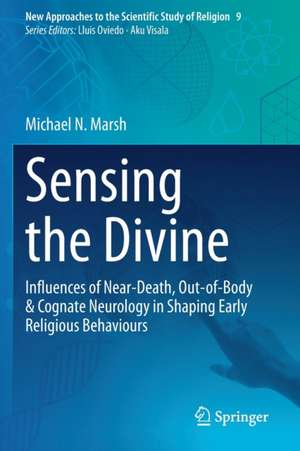Sensing the Divine: Influences of Near-Death, Out-of-Body & Cognate Neurology in Shaping Early Religious Behaviours: New Approaches to the Scientific Study of Religion, cartea 9
Autor Michael N. Marshen Limba Engleză Paperback – 12 aug 2022
As the author points out, key aspects of ND/OBE are thematic of all later established religions. These include journeys to heaven, sightings of brightly-lit godlike figures, and dead people now alive. Thus, ND/OBE could be the originating source of these spiritual motifs. To this, the author adds a fourth factor: various brain influences contribute to or modulate ND/OBE. Such cognate neurological disorders include REM-sleep intrusions, sleep paralysis, narcolepsy, and the Guillain-Barré syndrome. Errors due to aberrant switching between key neural control centers disrupt critical state-boundaries between consciousness and dreaming. This may induce NDE. Thus, in this state, subjects temporarily fail to understand where they are, undergo loss of self, and detached from the world. They imagine a “union with Gods.” Here, then, is the biological basis of ineffability.
Ancient humans gained beliefs about the "supernatural" through day-to-day existence. This book argues that near death experiences and cognate neurological conditions, some genetically-determined, could have facilitated, even augmented such beliefs. Hence, in configuring another realm of “spiritual” experience beyond the known environment, these neurological possibilities offer effective traction.
| Toate formatele și edițiile | Preț | Express |
|---|---|---|
| Paperback (1) | 693.57 lei 6-8 săpt. | |
| Springer International Publishing – 12 aug 2022 | 693.57 lei 6-8 săpt. | |
| Hardback (1) | 699.77 lei 6-8 săpt. | |
| Springer International Publishing – 11 aug 2021 | 699.77 lei 6-8 săpt. |
Preț: 693.57 lei
Preț vechi: 815.97 lei
-15% Nou
Puncte Express: 1040
Preț estimativ în valută:
132.71€ • 138.56$ • 109.84£
132.71€ • 138.56$ • 109.84£
Carte tipărită la comandă
Livrare economică 05-19 aprilie
Preluare comenzi: 021 569.72.76
Specificații
ISBN-13: 9783030673284
ISBN-10: 3030673286
Ilustrații: IX, 216 p.
Dimensiuni: 155 x 235 mm
Greutate: 0.33 kg
Ediția:1st ed. 2021
Editura: Springer International Publishing
Colecția Springer
Seria New Approaches to the Scientific Study of Religion
Locul publicării:Cham, Switzerland
ISBN-10: 3030673286
Ilustrații: IX, 216 p.
Dimensiuni: 155 x 235 mm
Greutate: 0.33 kg
Ediția:1st ed. 2021
Editura: Springer International Publishing
Colecția Springer
Seria New Approaches to the Scientific Study of Religion
Locul publicării:Cham, Switzerland
Cuprins
Chapter 1. The ND/OBE & the ‘Sensing of the Divine’: Introductory Review.- Chapter 2. Ancient Man: The Archeological Background.- Chapter 3. The Spiritual Nature of Mankind and its Genetic Components.- Chapter 4. An Account of the Near-Death Experience.- Chapter 5. … And the Out-of-Body Component.- Chapter 6. State Boundary Control, including Sleep Disorders.- Chapter 7. Framing the ‘Sense of the Divine’ from ND/OBE Phenomenology.- Chapter 8. Additional Neurological Inputs to Religious Experience.- Chapter 9. Is Religion always an Adaptive Phenomenon?.- Chapter 10. Theological Considerations of ND/OBE as Sources of the Sensed Divine.- Chapter 11. Summary.
Notă biografică
Professor Michael Marsh, formerly in academic medicine, read Theology at Oxford in retirement, followed by his thesis on OB/NDE (OUP, 2010). Since then he published on assisted dying; of being disabled; and arguing a theologically-based approach to abortion, much summarised in “On Being Human:” (JH Hunt: NY, 2016). His background permits unusually biologically-based approaches to philosophical and theological problems.
Textul de pe ultima copertă
This book proposes another unique basis for the origins of religion from disturbances in brain function. It proposes the novel idea that near-death and out-of-body experiences (ND/OBE) engendered “a sense of the divine” in ancient man.
As the author points out, key aspects of ND/OBE are thematic of all later established religions. These include journeys to heaven, sightings of brightly-lit godlike figures, and dead people now alive. Thus, ND/OBE could be the originating source of these spiritual motifs. To this, the author adds a fourth factor: various brain influences contribute to or modulate ND/OBE. Such cognate neurological disorders include REM-sleep intrusions, sleep paralysis, narcolepsy, and the Guillain-Barré syndrome. Errors due to aberrant switching between key neural control centers disrupt critical state-boundaries between consciousness and dreaming. This may induce NDE. Thus, in this state, subjects temporarily fail to understand where they are, undergo loss of self, and detached from the world. They imagine a “union with Gods.” Here, then, is the biological basis of ineffability.
Ancient humans gained beliefs about the "supernatural" through day-to-day existence. This book argues that near death experiences and cognate neurological conditions, some genetically-determined, could have facilitated, even augmented such beliefs. Hence, in configuring another realm of “spiritual” experience beyond the known environment, these neurological possibilities offer effective traction.
As the author points out, key aspects of ND/OBE are thematic of all later established religions. These include journeys to heaven, sightings of brightly-lit godlike figures, and dead people now alive. Thus, ND/OBE could be the originating source of these spiritual motifs. To this, the author adds a fourth factor: various brain influences contribute to or modulate ND/OBE. Such cognate neurological disorders include REM-sleep intrusions, sleep paralysis, narcolepsy, and the Guillain-Barré syndrome. Errors due to aberrant switching between key neural control centers disrupt critical state-boundaries between consciousness and dreaming. This may induce NDE. Thus, in this state, subjects temporarily fail to understand where they are, undergo loss of self, and detached from the world. They imagine a “union with Gods.” Here, then, is the biological basis of ineffability.
Ancient humans gained beliefs about the "supernatural" through day-to-day existence. This book argues that near death experiences and cognate neurological conditions, some genetically-determined, could have facilitated, even augmented such beliefs. Hence, in configuring another realm of “spiritual” experience beyond the known environment, these neurological possibilities offer effective traction.
Caracteristici
Presents a unique view on the origin of religion from disturbed brain function Studies the influence of cognate neurological disorders on near-death experiences Details how key aspects of near death experiences are themes in established religions












